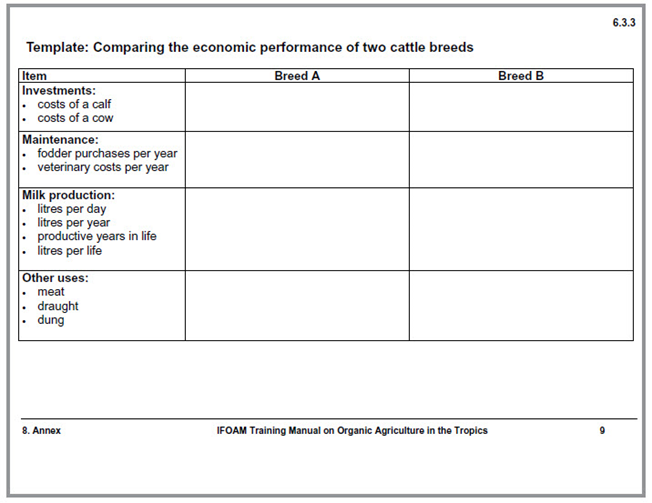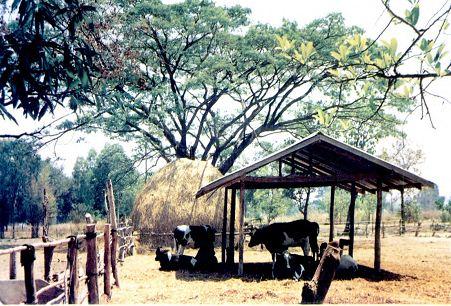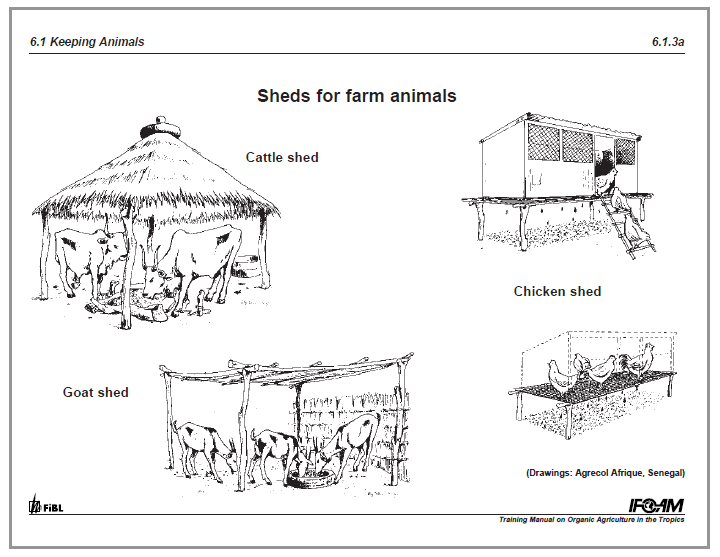General information about breeding, keeping and feeding animals based on IFOAM organic norms.
Contains information on minimum space and water consumption.
Breeding in Organic Farming
Principles and Methods
Breeding animals which are strong and robust and adapted to the local conditions is an important strategy for health promotion and disease prevention. Indigenous breeds of farm animals may be a good starting point for organic animal breeding. Animals can be improved by selection of individuals specially adapted to their natural organic conditions. They can be crossbred with suitable exotic breeds, to get offsprings with desired genetic traits.
For breeding, organic farming uses natural reproduction techniques, keeping bulls at the farm for natural mating.
Although Artificial Insemination (AI) is allowed, we do not promote AI Techniques but rather natural breeding systems based on the integrity of animals, which AI techniques do not respect.
Breeding in organic animal agriculture is based on the following requirements (IFOAM Norms, 2012): :
- 5.4.1 Breeding systems shall be based on breeds that can reproduce successfully under natural conditions without human involvement.
- 5.4.2 Artificial Insemination is permitted
- 5.4.3 Embryo transfer techniques and cloning are not allowed.
- 5.4.4 Hormonal therapy to induce ovulation and birth are prohibited unless applied to individual animals for medical reasons and under veterinary supervision
Breeding Goals
Over the last decades, indigenous breeds have been replaced by high producing exotic breeds and their crosses . Similar to high yielding plant varieties, these new animal breeds usually depend on a rich diet (concentrates), a huge amount of water and optimal / protected living conditions, because they are relatively susceptible to disease. It can be very expensive to keep such animals. Some of the conventional animals are even bred from lines which consumed a lot of veterinary treatments, which may contributes to less robust animals and dependency on veterinary inputs. When focusing only on one breeding goal such as high yield, we often lose other abilities, which have to do more with robustness.
As emphasized above, many organic farmers do not keep animals only for production, but also many other purposes and all of them should be considered in the breeding goals.
Organic animal breeding should optimise the overall use of farm animals, with considerations given to the local conditions and available fodder.
 |
| Organic animal breeding should optimise the overall use of farm animals, with considerations given to the local conditions and available fodder: breeding goals for poultry and cattle breeding |
|
© IFOAM Training Manual for Organic Farming in the Tropics
|
Is maximum performance or life production a relevant breeding goal in organic herds?
When comparing the production of different breeds of cows, the daily or yearly production or daily weight gain are used. However, high performing exotic breeds usually have a shorter life span than indigenous breeds with lower production.
Below, a figure illustrates some factors which can be discussed in relation to priorities regarding breeding animals, and comparing breeds of cows.
Template for comparing the economic performance of two cattle breeds
 |
| Illustration: Table for comparing the economic performance of two different breeds |
|
© IFOAM Training Manual for Organic Farming in the Tropics
|
Keeping animals outdoor and indoor
 |
| Housing |
|
© Falvey
|
It is crucial to keep animals in ways which allow them to move freely, as emphasized in the IFOAMs Norms 2012 (5.1.3, page 43):
In particular, the operator shall ensure the following animal welfare conditions:
- Sufficient free movement and opportunity to express normal patterns of behavior, such as space to stand naturally, lie down easily, turn around, groom themselves and assume all natural postures and movements such as stretching, perching and wing flapping;
- Sufficient fresh air, water, feed and natural
- Access to resting areas, shelter and protection from sunlight, extreme temperatures, rain, mud and wind.
This applies both on indoor or outdoor rearing systems, and it is emphasized that this is also possible when tethering on grass. Specifically about outdoor keeping, according to IFOAMs Norms (2012; point 5.1.8) 'All animals shall have unrestricted and daily access to pasture or a soil-based open-air exercise area or run, with vegetation, whenever the physiological condition of the animal, the weather and the state of the ground permit. Such areas may be partially covered. Animals may temporarily be kept indoors because of inclement weather, health condition, reproduction, specific handling requirements or at night. Lactation shall not be considered a valid condition for keeping animals indoor'.
In many smallholder tropical farming systems, this is difficult, and there are many ways of trying to solve this. The latest version of IFOAM's Norms states that 'On holdings where, due to their geographical location and structural constraints, it is not possible to allow free movement of animals, tethering of animals may be allowed for a limited period of the year or of the day. In such cases, animals may not be able to turn around freely but other requirements of 5.1.3 must be fulfilled'.
The pros and cons for shed feeding versus grazing is discussed below in relation to feeding; this is an area where the integration of animals into the farm should be very carefully thought through, including how the different elements can support each other.
The IFOAM Norms (2012) also says that herd animals such as cows which always live in a group, must not be kept in isolation from other animals of same species, although acknowledging that this will not be possible in some smallholder farms where they e.g. only have one animal. In special cases, isolation is acceptable, such as when keeping males from females or in case of disease. If there is only one animal of a species on a farm, good human contact or contact with other animal species will help.
Outdoor access as well as indoor housing conditions will be managed differently for different animal species and this will be specifically dealt with under each of the animal species.
Indoor housing conditions
With the exception of nomadic lifestyles, most farm animals are temporarily kept in sheds. The combination of animal husbandry and other farm activities requires that the animals are kept under control to avoid damage to crops. As emphasized above, they should be allowed free movements (IFOAMs Norms 5.1.3). Furthermore, the Norms point to need that the 'building construction provides for insulation, heating, cooling and ventilation of the building, ensuring that air circulation, dust levels, temperature, relative air humidity, and gas concentrations are within levels that are not harmful to the livestock'. This includes the requirement that there should be sufficient aeration, but no draught. The Norms also say that 'no animals shall be kept in closed cages', and 'animals are protected from predation by wild and feral animals'. Lastly, it is also emphasized that the amount of artificial light should be limited - this applies more for large, industrialized farms than for most smallholders.
Hygiene must be emphasized: there should be as little contact as possible between the animals and their own manure, both for their own health and wellbeing, and also for human health.
IFOAMs norms say that construction material and production equipment that might significantly harm human or animal health shall not be used. For economic reasons, sheds can be built with simple, locally available materials.
Many countries have a rich tradition of shed constructions and have developed the most efficient and appropriate shed systems for the conditions of the region. If techniques of this heritage are combined with the above principles, a locally adapted and at the same time animal friendly system may be obtained.
Examples of sheds for different farm animal species are shown on the right side, and will be discussed in more detail under each animal species.
Bedding material
'Where animals require bedding, adequate natural materials are provided. Bedding materials that are normally consumed by the animals shall be organic (IFOAMs Norms 2012, point 5.1.7 p. 45).'
Bedding materials should be used in sheds to keep the lying area of the animals soft, dry, and clean. This is important for their health and wellbeing. The beddings need to be replaced regularly, and can be used in the gardens as compost, which recycles nutrients to the plant and improves soil fertility. Examples of bedding material include straw, leaves, twigs, husks or other locally available material. They can be replaced daily or kept for several months while adding fresh material on top, and letting the material in the 'mat' compost. (the mat is the mattress, if you apply material on top of other material without removing the old straw or leaves or whatever material you have before applying new.
 |
| Traditional simple sheds in Senegal: cattle shed, goat shed, chicken shed |
|
© IFOAM Training Manual for Organic Farming in the Tropics
|
Feeding animals
Organic animals receive their nutritional needs from organic forage and feed of good quality (IFOAM Norms, 2012; General Principle of Animal Nutrition, 5.6). Animals shall be offered a balanced diet that provides all of the nutritional needs of the animals in a form allowing them to exhibit their natural feeding and digestive behavior (IFOAM, 2012, 5.6.2),
Organic animal feeding should be mainly based on fodder produced on the farm, and this is an important aspect of a well-balanced organic farming systems. According to IFOAM's requirements, at least 50% of the feed must be from the farm or from other organic farmers in the area. The health and wellbeing of animals is strongly linked to feeding. Fodder production should be integrated into the crops and other plant productions on the farm.
Organic animals must be fed organic feed - that means the feed does not contain pesticides and artificial fertilizer and is a part of a farming system which farm in accordance with the organic principles . Exceptions can be made if there is a very limited amount of organic feed in the area. From the farm itself, it is permitted to use feed produced on the farm as 'organic feed' to the farm's own animals during the first year of organic management.
Support the health of animals with a well-balanced diet
It is important for all animals to have a well-balanced diet which meet their nutritional needs. A part from physiological maintenance, the dietary requirements of the animal will also depend on whether the animal is kept for milk, beef or draught power. From an economical perspective, it is better to limit the number of animals and give them all sufficient feed, if resources are limited.
Likewise, different animals require different amounts and composition of feed in different physiological situations. The details about this can be found under each animal species, and so are the signs of deficiencies and imbalances for each animal species.
Minimum Space and Water Consumption
| Type of animal | Minimum space per animal | Water consumption in litres/day per animal |
| Bovine and Equine (adults) Cattle/Donkey/Horse | 4.0 m2/animal | 30-80, donkeys and mules need twice a day 10-25 or as much as they can drink |
| Camels | - | daily 15-30 or every 5-8 days as much they can drink: up to 100 litres or 1/3 of bodyweight |
| Sheep and goats (adults) | 1.5 m2/animal | 5-20 |
| Porcine (pigs) (>40 kg) Sow with piglets |
1.0 m2/animal 3.0 m2/animal |
15-25 10-25 |
| Poultry (adults) chicken/duck/geese/turkey | 6.0 m2/animal | 0.5-0.75 |
| Rabbits | 0.3 m2/animal | 50-150 Millilitre per kg bodyweight |
NB: Water should be available at all times (except for camels- they can do with water every 5-8 days). The water must be clean and fresh. Young animals also need water, Even when they are feed on milk. Milk does not always meet their body fluid needs=, especially when they are active, in a warm, hot dry, and windy conditions.
Review process
- Dr. Mette Vaarst, veterinarian, and Gidi Smolders, agronomist, orgANIMprove (2014)
- Muhammad Kiggundu, Makerere University
- Aage Dissing
- Inge Lis Dissing
Information Source Links
- IFOAM Norms and Standards, 2012. Full title: 'The IFOAM Norms for organic production and processing' Version 2014. Die Deutsche Bibliothek - CIP Cataloguing-in-Publication-Data. ISBN 978-3-940946-99-7. Pp 134.
- IFOAM Training Manual for Organic Agriculture in the Tropics http://shop.ifoam.org
- Vaarst, M; Roderick, S.; Lund, V. et al. (2004): Animal Health and Welfare in Organic Agriculture, CAB International, Wallingford, UK.
- Wytze J. Nauta, Thesis, Wageningen University (2009), Selective Breeding in Organic Dairy Production,
- Wytze J. Nauta et al (2003) Vision of breeding for organic agriculture
